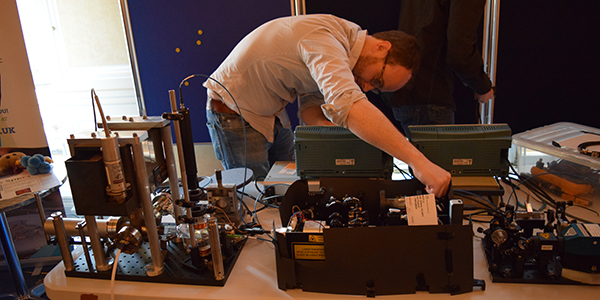Creating the coldest place on the universe
Living in Scotland, you get used to the cold winters. However, a group from Strathclyde' Physics Department decided to take things a step further, by creating the coldest place in the universe.
The Royal Society of Edinburgh was the department's chosen victim, which was made the coldest place in the universe - for one day only - as part of the Scottish launch of the International Year of Light.
How light affects us
Other than radioactivity, sunlight is the source of all energy on Earth, from the plants we eat to the fossil fuels we burn.
The year 2015 has been selected by the UN as the International Year of Light to recognise the huge number of ways that light affects all society.
Artificial lighting allows society to continue functioning after dusk. And then lasers find uses across industry and science, from cutting and welding metals, to medicine, to igniting nuclear fusion, and, perhaps strangely, to making the coldest spot in the universe.
Leaders in laser cooling
The physics department's Experimental Quantum Optics & Photonics (EQOP) group is a leader in the area of 'laser cooling', using carefully tuned lasers to cool clouds of atoms to millionths of a degree above absolute zero.
These laser-cooled atoms then form the starting point for a huge range of experiments; the EQOP group currently has experiments investigating atomic clocks, quantum information, matter-wave interferometry, and nonlinear optical forces, all of which require such atoms at such low temperatures. Typically, these experiments require labs full of state-of-the-art equipment and take many years to build. However, there is a now a push to miniaturise the apparatus required in order to make devices based on what is known as quantum technologies.
To demonstrate this new capability, over a single month Paul Griffin, a lecturer and Chancellor’s Fellow in the group, along with PhD students James McGilligan, Ivor Kresic, Vicki Henderson, Billy Robertson, and Rachel Offer, with colleagues in the Cassettari group at St Andrews, built a laser cooling system that needed only a square metre of bench space, including multiple lasers and an ultra-high vacuum chamber.
The launch
The entire setup was then loaded into a car, driven to the Royal Society of Edinburgh, and was up and running before 10am on the day of the launch. Hundreds of young and old members of the public, including many from Scottish high-schools, came through the day to see for themselves the coldest place in the universe. The exhibit proved extremely popular, as from 10am to 8pm the team answered questions and explained how lasers are used in the EQOP research labs, while at the same time keeping the whole apparatus operational.

It is hoped to make the portable laser cooling system available as a public engagement exhibit that can be used to demonstrate, in the coolest way, the ground-breaking research at Strathclyde.